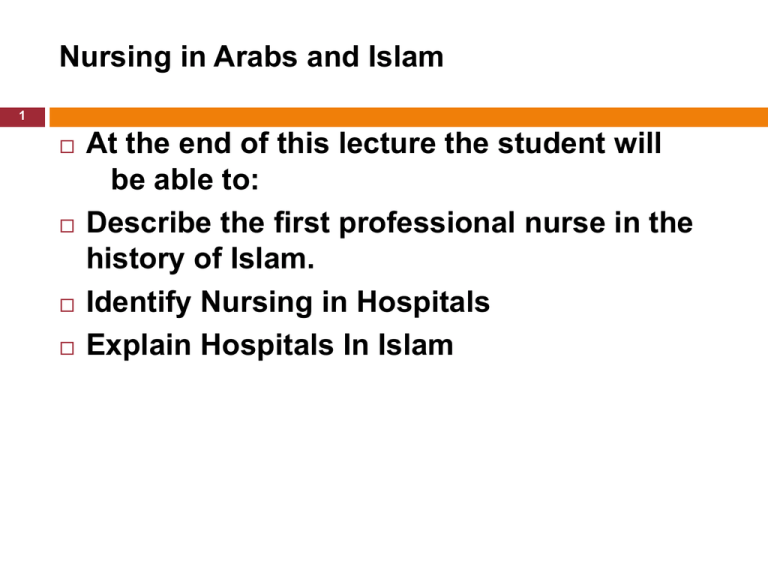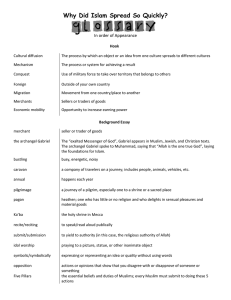Nursing in Arabs and Islam be able to:
advertisement

Nursing in Arabs and Islam 1 At the end of this lecture the student will be able to: Describe the first professional nurse in the history of Islam. Identify Nursing in Hospitals Explain Hospitals In Islam Arabs and Islam 2 In Islamic traditions caring is the manifestation of love for Allah and the Prophet Muhammad Caring in Islam is more than the act of empathy, instead, it consists of being responsible for, sensitive to, and concerned with those in need, namely the weak, the suffering and the outcasts of society This act of caring is further divided into three principles: Intention, thought, and action 3 Intention and thought refer to who/what/where/when/ and why to care Action is related to the knowledge necessary to be able to care In short, health care is deemed as service to the patients and to Allah, as opposed to other professions that are commercially-based This philosophy was the fundamental motivating factor for the majority of the doctors and nurses in the history of Islam Approach to Health Care Service 4 Another aspect of Islamic health care service that distinguishes it from contemporary Western health care industry is the holistic approach to health and wellbeing taken This holistic approach consisted of treating both the organic basis of the illness and the disease, and to provide spiritual support for the patient This spiritual component comes in the form of Tawheed (Oneness of Allah), a dimension lacking in current Western models of Nursing The First Muslim Nurse 5 The first professional nurse in the history of Islam is a woman named, Rufaidah bento Saad Al Aslamiah, from the Bani Aslam tribe in Madina Al Monawarah She lived at the time of Prophet Muhammad (saw) and was among the first people in Medina to accept Islam Rufaidah received her training and knowledge in medicine from her father, a physician whom she assisted regularly 6 After the Muslim state was established in Medina, she would treat the ill in her tent set up outside the mosque During times of war, she would lead a group of volunteers to the battlefield and would treat casualties and injured soldiers Rufaidah is described as a woman possessing the qualities of an ideal nurse: compassionate, empathetic, good leader and a great teacher, passing on her clinical knowledge to others she trained 7 Furthermore, Rufaidah’s activities as someone greatly involved in the community, in helping those at the more disadvantaged portions of society symbolize the ethos of care identified above. Nursing in Hospitals 8 In hospitals built in the Medieval Muslim society male nurses tended to male patients and female nurses to female patients The hospital in Al-Qayrawan was especially unique among Muslim hospitals for several reasons built in 830 H The Al-Dimnah Hospital, constructed in the Dimnah region close to the great mosque of Al Qayrawan, was quite ahead of its time. 9 It had the innovation of having a waiting area for visitors, and the first official female nurses were hired from Sudan to work in this hospital Moreover, aside from regular physicians working there, a group of religious Imams who also practiced medicine, called Fugaha al-Badan provided service as well, likely by tending the patients’ spiritual needs Hospitals In Islam 10 The capital of the Islamic caliphate empire kept changing from one dynasty to another In each capital, an important medical centre developed By the end of the 13th century, there were many medical centres spread throughout the Arab world Ash-Sham (Greater Syria) 11 Ash-Sham at that time included what is known now as Syria, Lebanon, Jordan, and Palestine., Damascus and Jerusalem were the important cities. Damascus: The first known hospital in Islam was built in Damascus in 706 A.D. by the Umayyad Caliph, Al-Walid Ibn Abdel Malik 12 The most important hospital built in Damascus in the middle ages was named An-Nuri Hospital, after King Nur Adl-Din Zinki in 1156. This hospital was built during the Crusades War, hence the importance of it being built was to fulfil a need for a well-equipped and well-staffed hospital It became not only be first class in care, but the hospital also was an excellent first class medical school 13 The king donated a whole library rich in medical books to the hospital. The hospital adopted medical records, probably being the first in history From its medical school, many eminent physicians graduated, for example Ibn Anl-Nafis, the scholar who discovered the pulmonary circulation system. The hospital served the public for seven centuries and parts of it still exist today. Jerusalem 14 In 1055 A.D., the Crusaders built Saint John's Hospital By the end of the 11th century, it expanded to such an extent to include a hospital, a palace for knights, and a convent for the nursing sisters The medical activities of the hospital were tremendous because of the large number of daily admissions of patients, pilgrims, and wounded soldiers 15 After the liberation of Jerusalem by Salah adDin in 1187 A.D., the hospital was renamed was changed into Al-Salahani Hospital He expanded the hospital, which continued to serve the people until its destruction by an earthquake in 1458 A.D. Iraq and Persia 16 Baghdad In 750 A.D., Baghdad was elected and built to be the capital of the Abbasid dynasty by the Caliph Abu-Ja’far Al- Mansur In 766 A.D., he assigned the dean of the medical school of Jindi Shapur, Judis IbnBabtishu', to be the court physician and establish hospitals proportionate to the glory and prosperity of Baghdad. 17 When Harun Al-Rashid followed (786-809 A.D.), he ordered the grandson of Ibn-Babtishu and his court physician, Jibril, to build a special hospital named Baghdad Hospital. This hospital developed into an important medical centre. One of its chiefs was Al-Raze, the eminent internist. In 918 A.D., the Caliph Al-Muqtadir built two hospitals in Baghdad. 18 One was on the east side of the city, which he named Al-Sayyidah Hospital, after his mother. The other was on the west side of the city, which he named, Al- Muqtadiri Hospital, after himself. Another important hospital was named Al-Adudi Hospital which was built in 981 A.D. after King Adud Al-Dawlah It was the most magnificent hospital built in Baghdad before modern times. 19 It was built at the request of the Caliph, who wanted to outdo his predecessors It was furnished with the best logistical equipment and supplies known at the time It had interns, residents, and 24 consultants attending its professional activities. It was destroyed in 1258 when the Mongols, led by Holagu the grandson of Genghis Khan, invaded Baghdad. Egypt 20 Al-Fustat In 872 A.D., Ahmed Ibn-Tulun built a hospital called Al-Fustat Hospital in the city Al-Fustat, which is now Old Cairo. It served the growing Cairo population for six centuries. It was divided into separate wards. On admission, the patients were given special clothes while their clothes, money, and valuables were stored until they were at the time of their discharge. 21 Cairo In 1284 A.D., King Al-Mansur Qalawun built the famous and important hospital named AlMansuri Hospital. The story behind its construction is interesting. King Al-Mansur Qalawun was an officer in the Muslim Arabian army fighting the Crusaders. While in the Holy Land, he fell sick and was admitted to An- Nuri Hospital. 22 On recovery, he vowed that if he ever became the ruler of Egypt, he would build a great hospital in Cairo, even more magnificent than An-Nuri Hospital, for, the sick, poor, and rich alike. At the inauguration ceremony, he asked for a cup of lemonade from the fountain, which was normally filled with water. 23 After drinking it he declared that by taking it, he was signifying that the hospital was serving all people from the king to the least of his subjects. This was the best hospital built at that time as reported by the contemporary travelers and historians of that time such as Ibn-Battuta and Al-Kalkashandi. It was divided into different sections according to medical ailments for different diseases. 24 Music therapy was used as a form of therapy treatment for psychiatric patients. It served 4,000 patients daily and the patient's stay in the hospital was free. Moreover, on his discharge, the patient was given food and money for compensation for being out of work during his hospital stay. Al-Mansuri Hospital has served Cairo for seven centuries since it's opening has been built. 25 It is now used for ophthalmology and renamed Qalawun Hospital Its magnificent ancient door is preserved in the Islamic Museum of Cairo North Africa 26 Tunisia In 830 A.D., Prince Ziyadat Allah I, built AlQayrawan Hospital in a district of the Qayrawan city called Al-Dimnah. Subsequently all hospitals in Tunisia were called Dimnah instead of Bimaristan as they were called in the East, which is a Persian word meaning a hospital. 27 The Qayrawan Hospital was characterized by spacious separate wards, waiting rooms for visitors patients, and female nurses from Sudan. The hospital also had a prayer hall. 28 Morocco In 1190 A.D., The king Al-Mansur Ya'qub IbnYusuf built a hospital in the capital city, Marakesh, and named it the Marakesh Hospital. It was a huge hospital beautifully landscaped with fruit trees and flowers. Water entered all the sections through aqueducts. Patients were provided with special apparel: one for winter and another for summer. 29 The pharmacy was taken care of by specialists called the Saydalah and there was an expensive private section where each patient was charged what is equivalent today to $1,501 a day. One thousand years ago, this fee was quite expensive. 30 Andalusi (Spain) In 1366 A.D., Prince Muhammad Ibn-Yusuf Ibn Nasr built the Granada Hospital in the city of Granada (Ghirnata), which had a population of expanded to half a million population. The hospital represented the beauty of IslamicArabic architecture in Spain and served the people until the fall of Granada in 1492 A.D 31 Thank You





